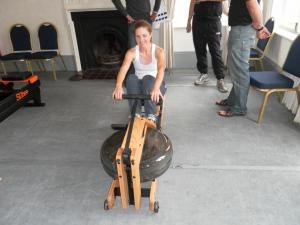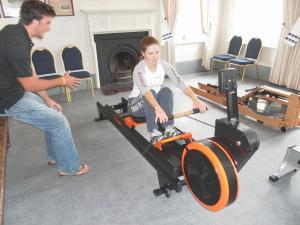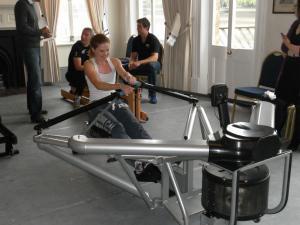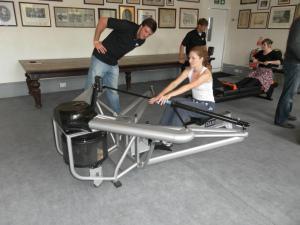It’s a bit of a cliché, but one I’m always grateful for. However feeble my erg score (and it’s feeble enough to be kept a closely guarded secret), I can always comfort myself with the thought that ergs don’t float – by which I mean that what you do on a rowing machine doesn’t necessarily translate into what happens on the water.
You can be all grunt and heft in the erg room and achieve massive, macho scores, but if your technique on the water is lousy – if you’re missing the catch until half way through the stroke, or you’re flying up the slide like an elephant on castors – you can waste all of your (admittedly impressive) efforts.
So if there were an erg that mimicked what happened on the water in any sort of realistic way, we’d all be pretty interested, right? Well, yesterday I had the chance to try out some WaterRower rowing machines that claim to be the nearest thing you can get on land to the real thing.
My attempts on the various models were overseen by Leander rower and Olympic hopeful Alan Sinclair, whose most exciting claim to fame – and sorry, Al, for bringing this up rather than your more serious achievements – is being Robbie Williams’ body double in the video for The Flood (just pausing for a moment here to let the Take That! fans pick themselves up off the floor).
Anyway, with Alan there to help me, what could possibly go wrong?

On the WaterRower and still smiling
First on trial was the basic WaterRower, which you’ll probably be familiar with. It was smoother and quieter than a Concept2 (sorry to mention them, but if I don’t, someone will). Other than that, it felt pretty familiar.

What a face! This is harder than it looks...
Definitely a step up was the Oartec Slider. This is a dynamic rowing machine that is designed to give the most realistic feeling of rowing on the water, and is supposed to be kinder to your back. What marks it out from a static one is that the frame moves (if you’ve ever put a static erg on a frame, you’ll have an idea what this feels like). When you push off with your legs, they move away from you, rather than you moving away from them. The whole experience is more fluid – always good in a water sport.
I can’t deny I didn’t quite get the hang of it in the short time I had to try it out, which explains the faces I was pulling (probably just as well that you can’t see Alan’s face as he watches my efforts…). I was pinging backwards and forwards, sometimes hitting front stops and sometimes back stops, which is not how it’s supposed to work. I would imagine, though, that if you can get to grips with it, it could be a very useful bit of kit.

What could possibly go wrong?
Finally, the machine I’d been waiting to try – the Oartec simulator. It’s huge and metallic and looks like something that would-be astronauts might use to test their suitability for space travel (though I’m assured it does fold down into a more storable size). What is so unusual about it is that rather than just having a straight handle on a chain, it is rigged with separate, solid handles for sculling or for bow or stroke-side rowing.
This really is more like the real thing. We had it rigged for sculling, and the motion really did feel exactly like the sequence of movements in a sculling boat (right down to the sculler’s knuckle that I managed to sustain within a minute of climbing aboard). On the erg you don’t use exactly the same muscles, especially on the upper body, as you do in a boat; with this one it was much more familiar.
Again,

"Have you started pulling yet?"
it took a little while to get used to it and to get even a moderately respectable score (I’ll never live down my shame when Alan peered at the monitor and asked if that was the sort of score that I’d normally be achieving. No one is supposed to know). But I really think I could come to love it (all right, like it, at least).
For a start it looks really cool (come on, that matters!) and anything that is less like an erg and more like a boat is always a winner for me. Best of all, if you’re looking to improve, you could use it to work on your technique in a meaningful way.
So, as I said, with Alan in charge, what could possibly go wrong? Well, nothing much, except for the small matter of me breaking one of the machines. And which one do you imagine I managed to break? Yes, you guessed it.
Of course, they were all very lovely about it and said it wasn’t really broken and there was just a belt that needed re-attaching or something. But still…
Ah well. Even if my erg scores are nothing to write home about, at least I’ve shown that I’m strong enough to break a monster machine. That has to count for something.
